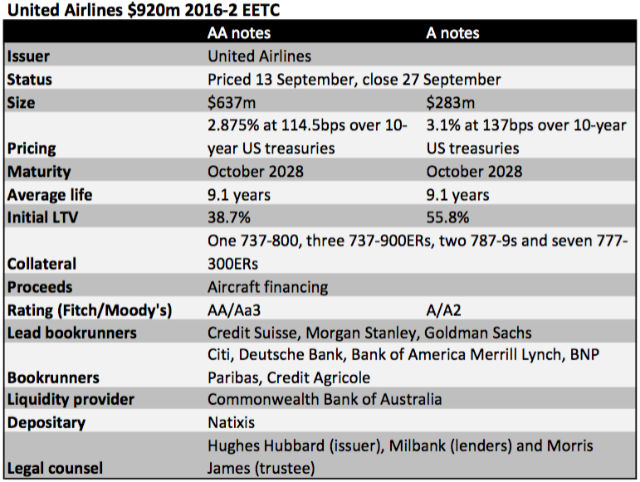Market forces coalesced around United Airlines’ $920 million enhanced equipment trust certificate (EETC) transaction earlier in September, resulting in a record low sub-3% coupon that even frequent issuer American Airlines could not match less than a week later.
Chicago-based United’s 2016-2 notes achieved a 2.875% coupon on the $637 million senior AA notes – the first ever below 3% for a EETC – and a 3.1% coupon on the $283 million A notes on 13 September. Both tranches mature in October 2028 and have an average life of 9.1 years.
The initial loan-to-value (LTV) ratio is 38.7% on the AA notes and 55.8% on the A notes, the prospectus shows.

Forces ranging from the AA/A tranche structure debuted by Delta Air Lines in 2015 to respect for United’s treasury team led by Gerry Laderman and the downward track in EETC interest rates in recent years all contributed to the record low rate, lenders close to the deal say. They confirm that the AA notes are the first EETC with a coupon below 3%.
“All four factors lined up on Monday for you to pierce the 3% threshold,” says a source. Investors insatiable appetite for yield was the fourth factor, they add.
The AA notes were roughly 2x oversubscribed while the A notes were between 3x and 3.5x oversubscribed, sources say.
Well-known large accounts were the primary buyers of the United 2016-2 paper. However, the deal did attract more interest from European accounts as well, they say.
The same forces did not coalesce in the same way for American’s $814 million 2016-3 notes on 19 September. The debt priced with a coupon of 3% on the $558 million AA notes and 3.25% on the $256 million A notes, both of which are also due in October 2028.
The spreads on the United paper were also tighter.
The carrier's 2016-2 AA notes priced at 114.5bps and its A notes priced at 137bps, both over 10-year US treasuries on 13 September.
American’s 2016-3 AA notes priced at 130bps and its A notes priced at 155bps, both over the same base rate six days later – a 15.5bps and 25bps premium, respectively, to the prior deal.
The yield on the 10-year treasury note was 1.73% on 13 September and 1.7% on 19 September, US Department of Treasury data shows.
Asked why the American transaction priced wider than the United’s, one analyst says they expected it, pointing to the fact that the former’s debt regularly trades at least 10bps wider than the latter’s debt on the secondary market.
American also raises more debt on the capital markets than United, with the 2016-3 transaction bringing the total to $2.94 billion for 2016. Some frequent players in the EETC space may have hit their exposure limits for the airline’s paper this year due to its frequent issuance.
MEETING 2017 NEEDS
United financed 13 aircraft with the proceeds of its 2016-2 notes. The pool includes one Boeing 737-800, three 737-900ERs, two Boeing 787-9s and seven Boeing 777-300ERs, the latter completing its 777 financing needs for 2017.
The 737s will be delivered in December, the 787s in January and February 2017, and the 777s from March to June 2017.
The aggregate appraised value of the aircraft portfolio is $1.68 billion, the 2016-2 prospectus shows.
Fitch Ratings calls the transaction “overcollateralised”, a fact that drove its AA rating of the AA notes. However, it notes that the 777-300ER is a slightly weaker tier-one aircraft than the 737-800 or 787-9 due to the weakness in the secondary market for 777-200s and the imminent arrival of the 777X in 2020.
Asked whether the 777 collateral raised any questions among investors, one lender who worked on the deal says it “was not even a question”.
“Yes, the 777 has been in production for 15 years but there’s no replacement for it,” they say, referring to -300ER variant. “Does that really make a difference for you from an asset protection standpoint? No.”
United will initially base the 14 777-300ERs it has on order at its Newark hub, where it will use the aircraft to add capacity on high-demand, longer international routes already served by 777-200s. Potential markets include Delhi, Mumbai and Tel Aviv, as well as its Star Alliance partner Lufthansa’s Frankfurt hub.
The carrier plans to debut the 777-300ER on domestic proving runs from February 2017 before shifting the aircraft to international flying in the second quarter.
United financed its first seven 777-300ERs with proceeds from its $1.05 billion 2016-1 EETC in June. The first aircraft is due in December and the remaining 13 in 2017.
Fitch and Moody’s Investors Service rate the 2016-2 AA notes AA and Aa3, respectively, and the A notes A and A2.
Credit Suisse, Morgan Stanley and Goldman Sachs are the joint lead bookrunners, and Citi, Deutsche Bank, Bank of America Merrill Lynch, BNP Paribas and Credit Agricole are joint bookrunners.
Natixis is depositary, Commonwealth Bank of Australia is liquidity provider, Wilmington Trust is trustee and US Bank escrow agent.
Source: Cirium Dashboard



















